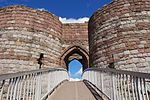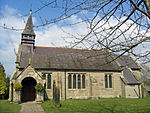Peckforton Castle

Peckforton Castle is a Victorian country house built in the style of a medieval castle. It stands in woodland at the north end of Peckforton Hills one mile (2 km) northwest of the village of Peckforton, Cheshire, England. It is recorded in the National Heritage List for England as a designated Grade I listed building. The house was built in the middle of the 19th century as a family home for John Tollemache, a wealthy Cheshire landowner, estate manager, and Member of Parliament. It was designed by Anthony Salvin in the Gothic style. During the Second World War it was used as a hostel for physically disabled children. The Tollemache family used the castle for occasional gatherings, but otherwise it was unused until 1969. From 1969 to 1980 the castle was leased by the 4th Lord Tollemache to George W. Barrett, and it again became a private residence and closed to the public. The right wing and tower and the castle gardens were restored by Barrett, an American employed by the U.S. Government. His daughter Pascale's wedding was the first to be held in the chapel and a special decree had to be obtained by the Archbishop of Canterbury to legally hold Catholic weddings in the grounds of the castle. During the 1970s and 1980s it was used as a location for shooting films and television programmes. The castle was bought in 1988 by Evelyn Graybill, who converted it into a hotel. In 2006 it was purchased by the Naylor family, who expanded its use to include hosting weddings, conferences and other functions.
Excerpt from the Wikipedia article Peckforton Castle (License: CC BY-SA 3.0, Authors, Images).Peckforton Castle
Horsley Lane,
Geographical coordinates (GPS) Address Website External links Nearby Places Show on map
Geographical coordinates (GPS)
| Latitude | Longitude |
|---|---|
| N 53.1175 ° | E -2.699 ° |
Address
Peckforton Castle
Horsley Lane
CW6 9TP
England, United Kingdom
Open on Google Maps










